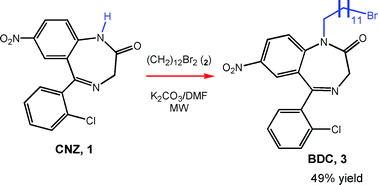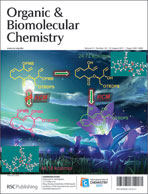A conjugable analogue of the benzodiazepine 5-(2-hydroxyphenyl)-7-nitro-benzo[e][1,4]diazepin-2(3H)-one containing a bromide C12-aliphatic chain (BDC) at nitrogen N1 was synthesized. One-pot preparation of this benzodiazepine derivative was achieved using microwave irradiation giving 49% yield of the desired product. BDC inhibited FNZ binding to GABAA-R with an inhibition binding constant Ki = 0.89 μM and expanded a model membrane packed up to 35 mN m−1 when penetrating in it from the aqueous phase. BDC exhibited surface activity, with a collapse pressure π = 9.8 mN m−1 and minimal molecular area Amin = 52 Å2/molecule at the closest molecular packing, resulted fully and non-ideally mixed with a phospholipid in a monolayer up to a molar fraction x ≅ 0.1. A geometrical–thermodynamic analysis along the π–A phase diagram predicted that at low xBDC (<0.1) and at all π, including the equilibrium surface pressures of bilayers, dpPC–BDC mixtures dispersed in water were compatible with the formation of planar-like structures. These findings suggest that, in a potential surface grafted BDC, this compound could be stabilize though London-type interactions within a phospholipidic coating layer and/or through halogen bonding with an electron-donor surface via its terminal bromine atom while GABAA-R might be recognized through the CNZ moiety.

You have access to this article
 Please wait while we load your content...
Something went wrong. Try again?
Please wait while we load your content...
Something went wrong. Try again?


 Please wait while we load your content...
Please wait while we load your content...